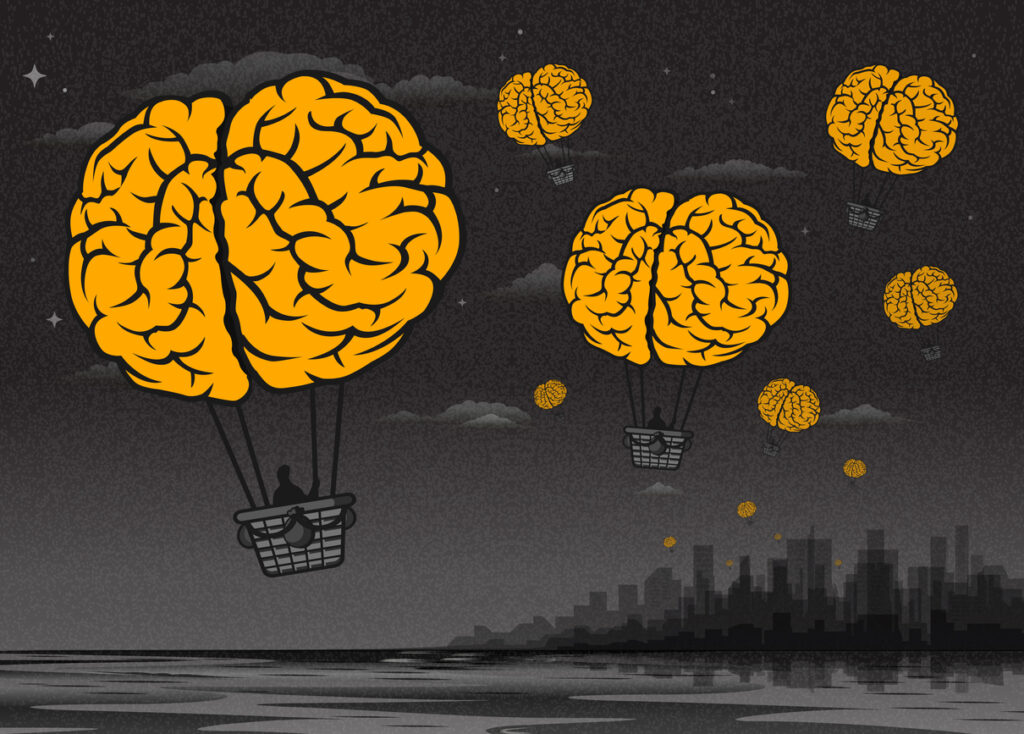We humans are creatures of habit that stick to our comfort-zones. Our brains typically follow the paths of least-resistance – doing what we’ve become accustomed to because it’s easy and we don’t have to think too hard about it. It makes sense in a way. Why make things any more difficult than they need to be? Especially if we enjoy doing those things, and they seem to work well for us.
Anything new or different requires us to think, which takes energy. It also takes us into a state of not-knowing, oftentimes accompanied by confusion. This can lead to feelings of incompetence, low self-esteem and anxiety. But we like to feel competent and capable, in control of our domain, and this is why change can be hard for us. Subsequently, we can sometimes be inflexible in our approach – resistant even, particularly if we don’t perceive the change to be beneficial.
Given that many changes taking place right now are about survival rather than progress, many people are struggling.
Those who’ve had to navigate a lot of change may be feeling battered, bruised and exhausted, like boats tossed around on the ocean.
The stronger a person’s self-esteem, and the more constructive their mindset, the easier they will be able to embrace and adapt to change. However, relatively few people currently have the kind of rock-solid self-esteem and mindset that enables them to be fully resilient to life’s changes and challenges.
Many have been raised in environments and times where mindset and optimal thinking weren’t widely spoken about and taught, and where criticism was more prevalent than encouragement.
Making change easier for your employees
Our change muscles are growing, but in reality it’s going to take a significant investment in learning and development (and positive input from management) to help transform people into the kind of constructively-focused, agile, shape-shifting beings that current circumstances are demanding!
Thankfully, we were created to be adaptable – it’s why we’ve survived thus far on our planet. The Covid-19 pandemic has taught us that we can endure all manner of difficulties, and even be strengthened by them.
There’s a lot that we can do to make change easier for people. Here are a few suggestions:
1. Have a clear vision
This should be well-defined, compelling and describe the desired future or direction of the business or organisation. There has probably never been a better time to re-imagine the future than now, and existing vision statements may need some updating.
2. Communication
Sharing the vision, along with a route-map for getting there and the all-important ‘whys’ for the change, is really important. This includes giving people the opportunity to question, challenge and make suggestions.
Consistency in communication is also important, so that even when there’s nothing new to share, this is communicated so that people aren’t left wondering (and worrying).
3. Competence
Change often involves upskilling and reskilling. Learning new skills and technologies can be stressful and difficult, and can cause confidence and self-esteem to wobble – particularly (though not exclusively) in older employees, who can sometimes take a little longer to learn. In order to feel calm and capable (and thus produce better results), people need excellent quality training and coaching.
4. Autonomy
Stress levels rise in proportion to the amount of control we perceive we have over things. A stressed workforce will be less productive, make more mistakes, and experience more sickness than a less-stressed workforce, so it’s helpful to give people as much control over the controllables as is safe and practical to give them.
5. Wellbeing
When change is stressful, employee wellbeing suffers – not just physical health, but mental and emotional health too. Our minds create our emotions, which affect our habits and behaviours, which impact our physical health (and vice versa).
These things are all influenced by what’s happening in our environment, hence we need to pay extra attention to wellbeing in times of change – both our own and other people’s.
6. Connection
Humans need social connection to thrive and flourish. Research shows that connection reduces anxiety and depression, increases happiness and strengthens the immune system. It also increases productivity. In fact, workplaces that facilitate the bringing together of people (even virtually) – not just for work, but also to socialise, play, eat, communicate and so on – achieve multiple benefits.
7. Self-esteem
Line managers can help build self-esteem just by understanding that people’s confidence can tumble during times of change and reskilling/upskilling. Being careful to offer constructive feedback rather than criticism; appreciating strengths and focusing on positive attributes; trusting people and believing in their capabilities; and offering extra support and coaching for those that need it, all help to uplift self-esteem and improve results.
8. Continuity
This is about keeping some semblance of consistency and continuity going where possible, to help minimise anxiety. Carefully consider, whilst implementing change, what can reasonably remain in place.
People thrive on routine and often talk about the ‘moving of goalposts’ being difficult or frustrating. Hot desking, in particular, can be very distressing for some people – particularly in the early days. What do people get a sense of comfort and security from in your work environment that you can keep in place?
Same storm, different boats
Those who’ve had to navigate a lot of change may be feeling battered, bruised and exhausted, like boats tossed around on the ocean.
Whilst some will be cruising along comfortably, others may be holding on for dear life. When line managers have an understanding of team members’ personal circumstances, they can offer an appropriate level of understanding and support.
With a little more empathy, we can help people sail through change.
Interested in this topic? Read ‘how to increase your adaptability.’
We humans are creatures of habit that stick to our comfort-zones. Our brains typically follow the paths of least-resistance – doing what we’ve become accustomed to because it’s easy and we don’t have to think too hard about it. It makes sense in a way. Why make things any more difficult than they need to be? Especially if we enjoy doing those things, and they seem to work well for us.
Anything new or different requires us to think, which takes energy. It also takes us into a state of not-knowing, oftentimes accompanied by confusion. This can lead to feelings of incompetence, low self-esteem and anxiety. But we like to feel competent and capable, in control of our domain, and this is why change can be hard for us. Subsequently, we can sometimes be inflexible in our approach – resistant even, particularly if we don't perceive the change to be beneficial.
Given that many changes taking place right now are about survival rather than progress, many people are struggling.
Those who’ve had to navigate a lot of change may be feeling battered, bruised and exhausted, like boats tossed around on the ocean.
The stronger a person’s self-esteem, and the more constructive their mindset, the easier they will be able to embrace and adapt to change. However, relatively few people currently have the kind of rock-solid self-esteem and mindset that enables them to be fully resilient to life’s changes and challenges.
Many have been raised in environments and times where mindset and optimal thinking weren’t widely spoken about and taught, and where criticism was more prevalent than encouragement.
Making change easier for your employees
Our change muscles are growing, but in reality it’s going to take a significant investment in learning and development (and positive input from management) to help transform people into the kind of constructively-focused, agile, shape-shifting beings that current circumstances are demanding!
Thankfully, we were created to be adaptable – it’s why we've survived thus far on our planet. The Covid-19 pandemic has taught us that we can endure all manner of difficulties, and even be strengthened by them.
There’s a lot that we can do to make change easier for people. Here are a few suggestions:
1. Have a clear vision
This should be well-defined, compelling and describe the desired future or direction of the business or organisation. There has probably never been a better time to re-imagine the future than now, and existing vision statements may need some updating.
2. Communication
Sharing the vision, along with a route-map for getting there and the all-important ‘whys’ for the change, is really important. This includes giving people the opportunity to question, challenge and make suggestions.
Consistency in communication is also important, so that even when there’s nothing new to share, this is communicated so that people aren’t left wondering (and worrying).
3. Competence
Change often involves upskilling and reskilling. Learning new skills and technologies can be stressful and difficult, and can cause confidence and self-esteem to wobble – particularly (though not exclusively) in older employees, who can sometimes take a little longer to learn. In order to feel calm and capable (and thus produce better results), people need excellent quality training and coaching.
4. Autonomy
Stress levels rise in proportion to the amount of control we perceive we have over things. A stressed workforce will be less productive, make more mistakes, and experience more sickness than a less-stressed workforce, so it’s helpful to give people as much control over the controllables as is safe and practical to give them.
5. Wellbeing
When change is stressful, employee wellbeing suffers – not just physical health, but mental and emotional health too. Our minds create our emotions, which affect our habits and behaviours, which impact our physical health (and vice versa).
These things are all influenced by what’s happening in our environment, hence we need to pay extra attention to wellbeing in times of change – both our own and other people’s.
6. Connection
Humans need social connection to thrive and flourish. Research shows that connection reduces anxiety and depression, increases happiness and strengthens the immune system. It also increases productivity. In fact, workplaces that facilitate the bringing together of people (even virtually) – not just for work, but also to socialise, play, eat, communicate and so on – achieve multiple benefits.
7. Self-esteem
Line managers can help build self-esteem just by understanding that people’s confidence can tumble during times of change and reskilling/upskilling. Being careful to offer constructive feedback rather than criticism; appreciating strengths and focusing on positive attributes; trusting people and believing in their capabilities; and offering extra support and coaching for those that need it, all help to uplift self-esteem and improve results.
8. Continuity
This is about keeping some semblance of consistency and continuity going where possible, to help minimise anxiety. Carefully consider, whilst implementing change, what can reasonably remain in place.
People thrive on routine and often talk about the ‘moving of goalposts’ being difficult or frustrating. Hot desking, in particular, can be very distressing for some people – particularly in the early days. What do people get a sense of comfort and security from in your work environment that you can keep in place?
Same storm, different boats
Those who’ve had to navigate a lot of change may be feeling battered, bruised and exhausted, like boats tossed around on the ocean.
Whilst some will be cruising along comfortably, others may be holding on for dear life. When line managers have an understanding of team members’ personal circumstances, they can offer an appropriate level of understanding and support.
With a little more empathy, we can help people sail through change.








